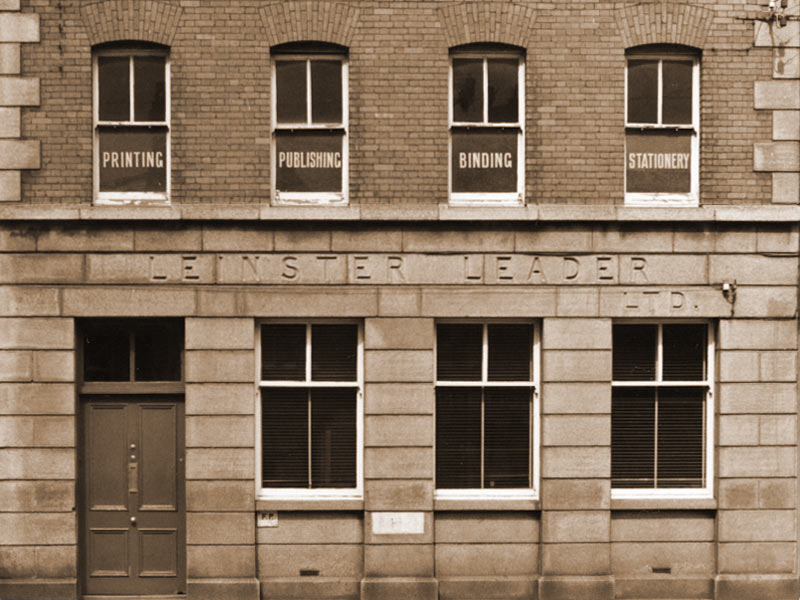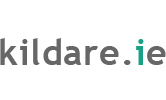
Beginning the 2nd of January 2016, the weekly editorials of the Leinster Leader for the year 1916 will be published on kildare.ie/ehistory.
The editor of the Leinster Leader at that time was Michael O'Kelly who, unknown to the British authorities, was Officer Commanding the Irish Volunteers in Naas. His editorials should prove an interesting insight into the political scene through the eyes of an active Irish Nationalist and literary figure in the county during this seminal year in our history, and act as a counter to the editorials published just up the other end of South Main Street in the offices of the Unionist orientated Kildare Observer.
Read the first Leinster Leader editorial of 1916 on the Co. Kildare Electronic History Journal:
http://www.kildare.ie/ehistory/index.php/leinster-leader-editorial-1-january-1916/
Background
As Kildare Historian-in-Residence James Durney has written, Galway-born brothers, Séumas and Michael O’Kelly, were both editors of the Leinster Leader during Ireland’s revolutionary period. Séumas was editor from 1906-1912, while Michael replaced his brother as editor when Séumas moved to Dublin. Subsequently, when Michael was interned, in the aftermath of the 1916 Rising, Séumas briefly replaced him until Michael was released from custody a few weeks later. Visit James's website for an outline of the brother's activities: http://www.jamesdurney.com/the-brothers-okelly-writers-poets-editors-and-nationalists/
In addition we have republished here an article from Liam Kenny's weekly Leinster Leader column, in which he recalls Michael O’Kelly’s part in plans for the 1916 Rising.
“Leader” editor embroiled in abortive Rising plan. by Liam Kenny
Newspaper editors are generally people with strong opinions. It is part of the job specification for editors to stimulate public debate on the topics of the week with a few well-chosen editorial paragraphs. In modern times editors are happy to let the ink do the talking but in years past some editors were not averse to giving substance to their opinions by swopping their typewriters for firearms. And that was certainly the case for one distinguished past editor of the Leinster Leader, Michael O’Kelly who occupied the editor’s desk for from 1912 to 1916. Michael O’Kelly took over from his brother Seamus who had been editor in 1906-12 and who was also an ardent nationalist but of a more gentle disposition. Seumas O’Kelly expressed his nationalism through plays and poetry and is commemorated by a plaque outside the Leinster Leader premises in South Main Street, Naas, which lauds him as “A gentle revolutionary”.
Michael O’Kelly was made of stronger stuff and was intimately bound up with revolutionary drilling and propaganda activity in Co Kildare in the years leading up to the 1916 Rising. Although there is no stone plaque for him, his legacy is recalled by the release of the extensive memoir which he recorded for the Bureau of Military History project in the early 1950s and which has now been released on-line courtesy of the Military Archives in Dublin.
His story can be taken up at the point where he admits to having acquired firearms and ammunition: “As the year 1915 closed, the possibility of a rising in the near future was rumoured. At this period a few of us had accumulated a fairly large amount of ammunition which I kept in a safe place in my house.”
He tells of meetings with other Irish Volunteer activists in early 1916. His co-conspirators included Tommy Harris of Prosperous (later to serve many years as a Kildare TD), Donal Buckley of Maynooth, P Colgan also Maynooth, Michael Smyth of Athgarvan, and Pat Dunne of Kill. The liaison with the Volunteer leaders in Dublin such as Pearse, Connolly and Clarke was Dr. Ted Kelly of Maynooth who called to Michael O’Kelly on Ash Wednesday 1916 and told him that the Volunteer leaders had made a plan to trigger an uprising on Easter Sunday.
Michael O’Kelly set about relaying the message to other members of the Naas Volunteer unit including Thomas Patterson of Main Street, Naas, and Thomas Traynor of Haynestown, near Kill. O’Kelly recalls: “They were both delighted that things were at last coming to a head with regard to the rebellion.” He had another visit from Dr. Kelly who revealed that Volunteer headquarters in Dublin had a specific plan for the Naas unit – to assist an explosives specialist who would blow up a bridge near Sallins station so as to prevent the British from rushing troops by rail from the Curragh to Dublin when the rising broke out in the capital.
On Easter Sunday O’Kelly recalls how he, Tom Harris and Dr. Kelly walked to the Dublin Road out of Naas where they were met with a despatch rider who handed over a message confirming that the rising would go ahead in Dublin at noon on Easter Monday.
O’Kelly’s central role in the preparations for military action around Naas is highlighted when his memoir reveals that Dr Kelly and Tom Harris came back to his house where they were given automatic revolvers and a good supply of ammunition. They agreed to mobilise the men in their sections and to rendezvous at noon on Easter Monday at Bodenstown churchyard – an appropriate location given Wolfe Tone’s iconic status in the republican creed. At great danger to himself considering that Naas was swarming with RIC men and British soldiers, O’Kelly contacted his lieutenants, Tom Traynor and Tom Patterson and “handed each his automatic”. He told them of the Bodenstown arrangement and said he would precede them to the agreed rendezvous.
However at this point the confusion which dogged the preparations for the Rising and resulted in little or no action outside of Dublin was to manifest itself. When O’Kelly reached Bodenstown he found no sign of any of the other Kildare volunteers: “… having walked in the direction of the historic old churchyard, I returned to the crossroads. Having waited there for some time, I concluded that something went amiss with the arrangements.”
He was to learn later that some of the Kildare volunteers had in fact assembled at a field close to the churchyard, had abandoned the plan to blow up the bridge near Sallins, and had instead made their way to Maynooth from where they trekked along the canal to Dublin to join Pearse and the others in the GPO. As a result there was no Volunteer action in Kildare in support of the Dublin rising.
However, this did not mean that Michael O’Kelly and his circle was free from surveillance by the Constabulary. He recalls the dramatic events of the Thursday of Easter week: “The next thing that happened was a sudden descent on my house by a party of Royal Irish Constabulary. Myself and my nephew, Alphie Sweeney, then 15, were placed under arrest and taken to the police barracks.” Ironically the RIC barracks in Naas shared a party wall with the Leinster Leader offices where O’Kelly had composed many a hard-hitting editorial in the cause of Irish nationalism.
Fortunately in modern times editors confine their revolutionary activities to the keyboard of a word-processor but Michael O’Kelly’s memoirs are a reminder of the days when newsmen were expected to be as proficient with the revolver as with the newsroom typewriter.
Series no: 294
http://www.kildare.ie/ehistory/index.php/leader-editor-embroiled-in-abortive-rising-plan/



